Egyptian Medicine › Egyptian Obelisk › Gregory the Great » Origins and History
Articles and Definitions › Contents
- Egyptian Medicine › Ancient History
- Egyptian Obelisk › Ancient History
- Gregory the Great & His Pastoral Care › Antique Origins
Ancient civilizations › Historical places, and their characters
Egyptian Medicine › Ancient History
Definition and Origins

Medical practice in ancient Egypt was so advanced that many of their observations, policies, and commonplace procedures would not be surpassed in the west for centuries after the fall of Rome and their practices would inform both Greek and Roman medicine. They understood that disease could be treated by pharmaceuticals, recognized the healing potential in massage and aromas, had male and female doctors who specialized in certain specific areas, and understood the importance of cleanliness in treating patients.
In the modern day it is recognized that disease and infection can be caused by germs and one might think people have always believed so but this is a relatively late innovation in human understanding. It was not until the 19th century CE that the germ theory of disease was confirmed by Louis Pasteur and proven by the work of British surgeon Joseph Lister.
Before either of them, the Hungarian physician Ignaz Semmelweis (1818-1865 CE) offered the then outlandish proposal to the medical community that they could cut mortality rates in their practices simply by washing their hands. He was mocked by doctors, who saw no reason to wash their hands before even the most invasive surgical procedures, and grew increasingly frustrated and bitter. Semmelweis was committed to a mental institution in 1865 CE where he died, after being severely beaten by guards, for suggesting a practice recognized as common sense today.
THE MORTALITY RATE FOLLOWING MEDICAL PROCEDURES IN ANCIENT EGYPT WAS PROBABLY LESS THAN THAT OF ANY EUROPEAN HOSPITAL IN THE CHRISTIAN ERA UNTIL THE MID-20TH CENTURY CE.
The ancient Egyptians would have accepted Semmelweis' proposal without hesitation; not because they understood the concept of germs, but because they valued cleanliness. The mortality rate following medical procedures in ancient Egypt was probably less than that of any European hospital in the Christian era until the mid-20th century CE when personal cleanliness and the sterilization of instruments became common practice.
Egyptologist Barbara Watterson notes that "medicine in ancient Egypt was relatively advanced and Egyptian doctors, who were all, with one or two exceptions, male, were skilled (46). Even so, for a civilization which regularly dissected the dead for embalming, doctors had little understanding of how most of the internal organs worked and blamed disease on supernatural forces.
INJURY & DISEASE
Injuries were easy to understand in ancient Egypt; disease was a bit more difficult. When someone was injured there was a plain cause and an effect which could then be treated; when a person was sick, however, the cause was less clear and so diagnosis more problematic.
The cause of disease was usually understood as the consequence of sin and, when that seemed not the case, that the patient was under a demonic attack, was being plagued by an angry ghost, or that some god felt they needed to learn a lesson.Disease, therefore, was commonly treated through recitation by a doctor of magical spells. Watterson notes, "the earliest 'doctor' was a magician, for the Egyptians believed that disease and sickness were caused by an evil force entering the body" (65).
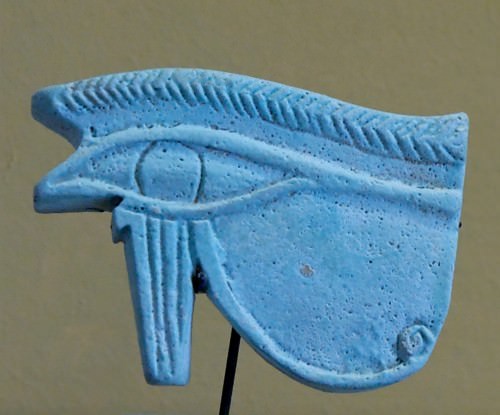
Eye of Horus
The types of diseases Egyptians suffered from were as numerous and varied as they are in the present day and included bilharsiasis (a disease contracted and spread through contaminated water); trachoma (an infection of the eye); malaria;dysentery; smallpox; pneumonia; cancer; heart disease; dementia; typhoid; arthritis; high blood pressure; bronchitis;tuberculosis; appendicitis; kidney stones; liver disease; curvature of the spine; the common cold, and ovarian cysts.
Besides magical spells, ancient Egyptians used incantations, amulets, offerings, aromas, tattoos, and statuary to either drive away the ghost or demon, placate the god or gods who had sent the illness, or invoke protection from a higher power as a preventative. The spells and incantations were written down on papyrus scrolls which became the medical texts of the day.
THE MEDICAL TEXTS
Although there were no doubt many more texts available in ancient Egypt, only a few have survived to the present. These few, however, provide a wealth of information on how the Egyptians saw disease and what they believed would alleviate a patient's symptoms or lead to a cure. They are named for the individual who owned them or the institution which houses them. All of them, to greater or lesser degrees, rely on sympathetic magic as well as practical technique.
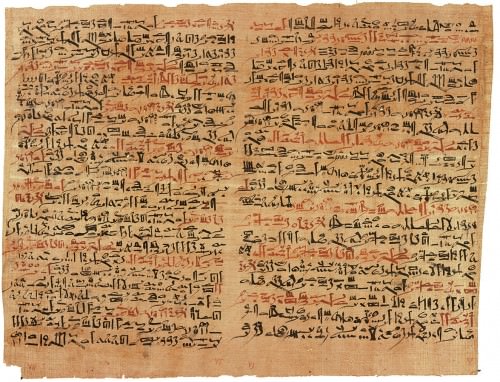
Edwin Smith Papyrus
The Chester Beatty Medical Papyrus, dated c. 1200 BCE, prescribes treatment for anorectal disease (problems associated with the anus and rectum) and prescribes cannabis for cancer patients (pre-dating the mention of cannabis in Herodotus, long thought to be the earliest mention of the drug). The Berlin Medical Papyrus (also known as the Brugsch Papyrus, dated to the New Kingdom, c. 1570 - c. 1069 BCE) deals with contraception, fertility, and includes the earliest known pregnancy tests.The Ebers Papyrus (c. 1550 BCE) treats cancer (for which, it says, there is no treatment), heart disease, diabetes, birth control, and depression. The Edwin Smith Papyrus (c. 1600 BCE) is the oldest work on surgical techniques. The Demotic Magical Papyrus of London and Leiden (c. 3rd century CE) is devoted entirely to magical spells and divination. The Hearst Medical Papyrus (dated to the New Kingdom) treats urinary tract infections and digestive problems. The Kahun Gynaecological Papyrus (c. 1800 BCE) deals with conception and pregnancy issues as well as contraception. The London Medical Papyrus (c. 1782-1570 BCE) offers prescriptions for issues related to the eyes, skin, burns, and pregnancy. These are only the papyrii recognized as focusing entirely on medicine. There are many more which touch on the subject but are not generally accepted as medical texts.
All of these works, at one time or another, were consulted by practicing doctors who routinely made house calls. The Egyptians called the science of medicine the "necessary art" for obvious reasons. Doctors were considered priests of the Per- Ankh, the House of Life, a kind of library/school attached to a temple, but the concept of the 'house of life' was also considered the healing knowledge of the individual doctors.
DOCTORS, MIDWIVES, NURSES, & DENTISTS
Physicians in ancient Egypt could be male or female. The "first physician", later deified as a god of medicine and healing, was the architect Imhotep (c. 2667-2600 BCE) best known for designing the Step Pyramid of Djoser at Saqqara. Imhotep is also remembered for initiating "secular medicine" through his treatises arguing that disease occurred naturally and was not a punishment from the gods. Women in the medical profession in Egypt go back to the Early Dynastic Period when Merit-Ptah was the royal court's chief physician c. 2700 BCE. Merit-Ptah is the first female doctor known by name in world history but evidence suggests a medical school at the Temple of Neith in Sais in Lower Egypt run by a woman whose name is unknown c.3000 BCE.

Knife & Leg Relief, Temple of Edfu
Pesehet (c. 2500 BCE), another female physician often cited as the first, was the "Lady Overseer of Female Physicians", possibly associated with the school at Sais, attesting to the presence of women in medical practice at this time. The famous legend of Agnodice of Athens (c. 4th century BCE) relates how, denied entrance to the medical profession because she was a woman, she went to Egypt where women were respected in the field. How and where doctors received their training is not known although it has been established there was an important school in Alexandria as well as the one at Sais.
A doctor not only needed to be literate but also pure in body and spirit. Doctors were referred to as wabau, ritually pure, and were expected to bathe as frequently and carefully as a high priest. Each doctor had his or her speciality but there were also swnw, general practitioners, and sau, whose speciality was in the use of magic. Midwives, masseurs, nurses, attendants, and seers also assisted the doctor. Doctors are not thought to have had anything to do with births, however, which were handled entirely by midwives and the women of the house. Egyptologist Carolyn Graves-Brown writes:
Midwifery appears to have been a solely female profession in ancient Egypt. That this was so is suggested by medical texts, which include gynaecological information, but do not discuss obstetrics. Additionally, men are never shown in birthing scenes, and in the Papyrus Westcar, the mother is assisted in birth by four goddesses.(82)
There is no evidence for medical training of midwives. In the Old Kingdom the word for 'midwife' is associated with the word for 'nurse', one who assisted a doctor, but this association ends after that period. Midwives could be female relatives, friends, or neighbors and do not seem to have been regarded as medical professionals.
The nurse could be female or male and was a highly respected medical professional although, as with midwives, there is no evidence of a school or professional training. The most essential kind of nurse was the wet nurse. Graves-Brown notes, "with the probable likelihood of high mortality of mothers, wet nurses would have been particularly important" (83). Women regularly died in childbirth and legal documents show agreements between wet nurses and families to care for the newborn in the event of the mother's death. The dry nurse, who would assist in procedures, was accorded such respect that he or she was represented during the time of the New Kingdom as linked with the divine. The association of the nurse with the doctor seems well established but not so much their link with the dentist.

Egyptian Woman Giving Birth
Dentistry grew out of the established medical profession but never developed as widely. The ancient Egyptians suffered from dental problems throughout the entire history of the civilization so why dentists were not more plentiful, or better documented, is unclear. Doctors also practiced dentistry but there were dentists as far back as the Early Dynastic Period. The first dentist known by name in the world, in fact, is Hesyre (c. 2600 BCE), Chief of Dentists and Physician to the King under the reign of Djoser (c. 2700 BCE). Dental problems were especially prevalent owing to the Egyptian diet of coarse bread and their inability to keep sand out of their food. Egyptologist and historian Margaret Bunson writes:
Egyptians of all eras had terrible teeth and peridontal problems. By the New Kingdom, however, dental decay was critical. Physicians packed some teeth with honey and herbs, perhaps to stem infection or to ease pain.Some mummies were also provided with bridges and gold teeth. It is not known if these dental materials were used by the wearer while alive or inserted in the embalming process. (158)
Queen Hatshepsut (1479-1458 BCE) of the New Kingdom died from an abscessed tooth as did many others. Toothaches and dental problems were thought to be caused by a tooth-worm which needed to be driven out by magical spells and incantations.This belief no doubt originated in Mesopotamia, specifically Sumer, where incantations against the tooth-worm have been found in ancient cuneiform inscriptions.
HEALING GODS, MEDICINES, & IMPLEMENTS
As with doctors, dentists used magical incantations to drive the tooth-worm from the patient and then applied what medicines they had to ease the pain. Doctors and dentists frequently used herbs and spices medicinally. A cure for chronic bad breath, for example, was chewing a gum ball of honey, cinnamon, myrrh, frankincense, and pignon. There is evidence of tooth extraction and false teeth with opium used as an anaesthetic. The importance of diet was recognized and changes in one's diet for improved health were suggested. Practical, hands-on, remedies were always applied first in cases of obvious physical injury but with toothaches or gum disease, as with any disease, a supernatural cause was assumed.
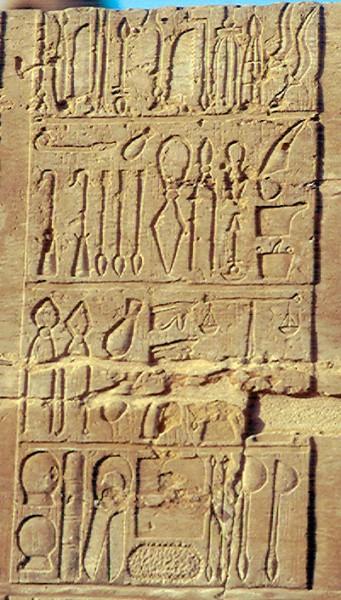
Egyptian Medical Instruments
A belief in magic was deeply ingrained in the Egyptian culture and was considered as natural and normal as any other aspect of existence. The god of magic was also a god of medicine, Heka, who carried a staff entwined with two serpents. This symbol was passed on to the Greeks who associated it with their god of healing, Asclepius, and which is recognizable today as the caduceus of the medical profession. Although the caduceus no doubt traveled from Egypt to Greece it originated in Sumer as the staff of Ninazu, son of the Sumerian goddess of healing Gula.
Besides Heka, there were a number of other important healing deities such as Sekhmet, Serket (also known as Selket ), Sobek, and Nefertum. The priests of Serket were all doctors, though not every doctor was a member of her cult. Serket and Sekhmet were regularly invoked in magical spells and incantations along with Heka and, in certain cases, other deities such as Bes or Tawawret (usually dealing with fertility/children's diseases). Sobek, the crocodile god, seems to have been largely invoked for surgeries and invasive procedures. Nefertum, the god of perfumes associated with the lotus and healing, was invoked in procedures which today would be recognized as aromatherapy. In the Kahun Papyrus a course regularly prescribed for women is to fumigate them with incense to drive out an evil spirit and Nefertum would have been called upon in these instances.
Along with spells and incantations, the Egyptian doctors used naturally occurring herbs and spices as well as their own creations. Bunson writes:
The pharmaceuticals of the ancient Egyptian priest-physicians included antacids, copper salts, turpentine, alum, astringents, alkaline laxatives, diuretics, sedatives, antispasmodics, calcium carbonates, and magnesia. They also employed many exotic herbs. All dispensing of medicines carefully stipulated in the medical papyri, with explicit instructions as to the exact dosage, the manner in which the medicine was to be taken internally (as with wine or food), and external applications. (158)
Surgical procedures were common and many instruments have been identified which are still in use today. The Egyptians had a flint and a metal scalpel, dental pliers, a bone saw, probes, the catheter, clamps for stopping blood flow, specula, forceps, lancets for opening veins, sponges, scissors, phials, bandages of linen, and scales for weighing the proper amount of raw materials to mix for medicines. Surgeries were frequently successful as evidenced by mummies and other remains found who survived amputations and even brain surgery for years. Prosthetic limbs, made usually of wood, have also been found.
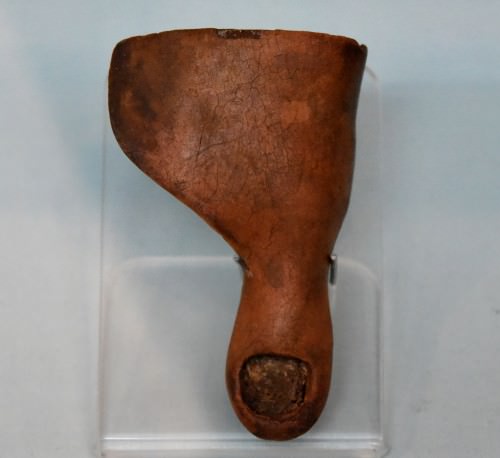
Prosthetic Toe of Painted Cartonnage
CONCLUSION
Not all of the medical practices in Egypt were so successful, however. Circumcision was a religious ritual performed on boys between the ages of 10 and 14 marking the transition from adolescence to manhood. It was performed by a doctor who also served as a temple priest, using a flint blade and reciting incantations, but in spite of their precautions this procedure still sometimes resulted in infection. Since the nature of the infection was unknown to them, it was considered the result of a supernatural influence and dealt with through magic spells; this most likely resulted in the deaths of many young men.
Because of their belief in the womb as connected to all parts of a woman's body, fumigation of the womb was a common prescription, accompanied by incantations, which would miss the actual cause of the problem. Eye problems were treated with a dose of bat's blood because it was thought the night-vision of the bat would be transferred to the patient; no evidence suggests this was effective.
Although the embalmers of Egypt no doubt came to understand how the organs they removed from the body worked with each other, this knowledge was never shared with doctors. These two professions moved in completely different spheres and what each did within their own job description was not considered relevant to the other. It is for this reason that, even though the Egyptians had the means of exploring internal medicine, they never did.
The heart, though recognized as a pump, was also thought to be the center of emotion, personality, and intellect; the heart was preserved in the deceased while the brain was scraped out and discarded as worthless. Although they recognized liver disease they had no understanding of the function of the liver and while regularly dealing with miscarriages and infertility, had no understanding of obstetrics. The culture's reliance on supernatural assistance from the gods prevented them from exploring more immediate and practical solutions to the medical problems they encountered daily.
Still, the Egyptian physician was widely respected for their skill and knowledge and was called upon by the kings and nobility of other nations. The Greeks especially admired the Egyptian medical profession and adopted a number of their beliefs and techniques. Later famous physicians of Rome and Greece - like Galen and Hippocrates ("father of modern medicine") - studied the Egyptian texts and symbols and so passed down the traditions to the present day.
Egyptian Obelisk › Ancient History
Definition and Origins
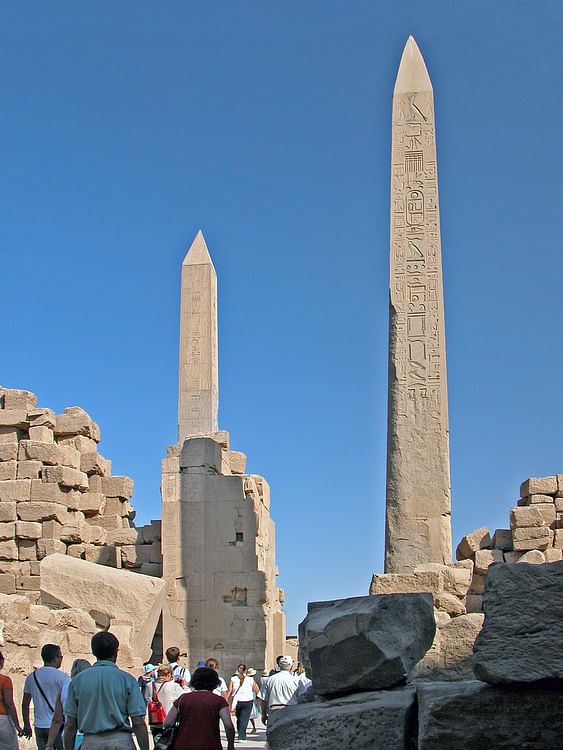
An obelisk is a stone rectangular pillar with a tapered top forming a pyramidion, set on a base, erected to commemorate an individual or event and honor the gods. The ancient Egyptians created the form at some point in the Early Dynastic Period (c. 3150-c. 2613 BCE) following their work in mud brick mastaba tombs and prior to the construction of the Step Pyramid of Djoser (c. 2670 BCE). It is thought that the earliest obelisks served as a kind of training for working in stone on monumental projects which was a necessary step toward pyramid building.
The name "obelisk" is Greek for "spit", as in a long pointed piece of wood generally used for cooking, because the Greek historian Herodotus was the first to write about them and so named them. The Egyptians called them tekhenu which means "to pierce" as in "to pierce the sky". The earliest obelisks no longer exist and are only known through later inscriptions but appear to have been only about ten feet (3 metres) tall. In time they would reach heights of over 100 feet (30 metres).Although many cultures around the world from the Assyrian to the Mesoamerican employed the obelisk form, only ancient Egypt worked in monolithic stone, almost always red granite. Each ancient Egyptian obelisk was carved from a single piece of stone which was then moved to its location and raised onto a base. While archaeologists and scholars understand how these monuments were carved and transported, no one knows how they were raised; modern day efforts to replicate the raising of an obelisk, using ancient Egyptian technology, have failed.
SYMBOLISM OF THE OBELISK
The obelisks of ancient Egypt represented the benben, the primordial mound upon which the god Atum stood at the creation of the world. As such, they were associated with the benu bird, the Egyptian precursor to the Greek phoenix. According to some Egyptian myths the benu bird was the first living creature whose cry awoke creation and set life in motion. The bird was linked to the morning star and the renewal of each day but was also the sign of the end of the world; in the same way the bird had cried to begin the creative cycle, she would sound again to signal its completion.
THE OBELISKS OF ANCIENT EGYPT REPRESENTED THE BENBEN, THE PRIMORDIAL MOUND UPON WHICH THE GOD ATUM STOOD AT THE CREATION OF THE WORLD.
The Egyptians believed a day would come when the gods would die and all would return to the uniformity of primordial chaos.The benu bird would not choose this end of its own but would be given its cue by the sun god Ra who, in turn, would have been informed by the god Thoth, keeper of the records of humans and gods. The benu bird was primarily linked, however, with Ra (later Amun and Amun-Ra) and with light and life. Egyptologist Geraldine Pinch comments on this:
From the Pyramid Texts onward, the benu bird was closely associated with the creator sun god. In Heliopolis, the center of solar worship, the benu bird was said to perch on the benben stone, a kind of primitive obelisk, or in the branches of a sacred willow tree. When Egyptian kings had reigned for thirty years, they asked the benu bird to renew their strength and vitality (117).
While keeping its association with the benu bird, the obelisk came to be increasingly associated with Ra and solar worship, especially from the New Kingdom (c. 1570-1069 BCE) onwards. Obelisks were always raised in pairs in keeping with the Egyptian value of balance and harmony; it was believed that the two on earth were reflected by two in the heavens.Egyptologist Richard H. Wilkinson writes:
The phenomenon of duality pervades Egyptian culture and is at the heart of the Egyptian concept of the universe itself. But rather than focusing on the essential differences between the two parts of a given pair, Egyptian thought may stress their complementary nature as a way of expressing the essential unity of existence through the alignment and harmonization of opposites - just as we today might use "men and women", "old and young", or "great and small" to mean "all" or "everyone" (129).
The dual obelisks were raised in honor of a great king's accomplishments (or, in the case of Hatshepsut, a great queen), but also served to honor the gods or, more often, a specific god. In the period of the New Kingdom the obelisk was thought to be inhabited by the spirit of the god it was raised for in the same way a god was thought to actually live in his or her temple.Thutmose III (1458-1425 BCE) of the New Kingdom instituted the ritual of offering ceremonies to obelisks in the same way that offerings were brought to temples and this practice continued through the Ptolemaic Period (323-30 BCE), the last to rule Egypt before it was annexed by Rome. The pharaohs of the New Kingdom erected more obelisks than any other in the belief that they would live on through these monuments as offerings would continue to be brought to them after their death.
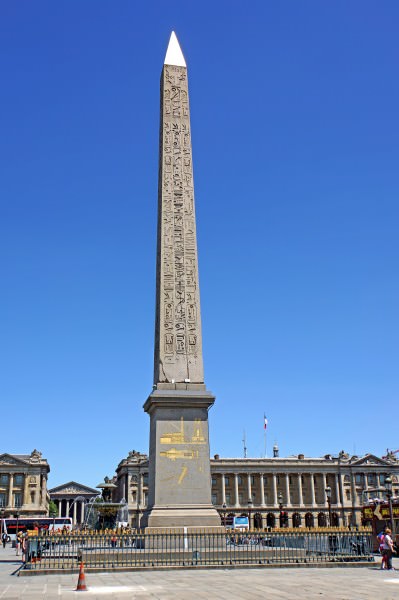
Luxor Obelisk, Paris
The obelisks, then, represented the living deity, the vitality and immortality of the pharaoh, and the concept of duality and balance. No matter who or what else they commemorated, though, they were raised and carefully positioned so that the first and last light of day would touch their peaks to honor the sun god. The sun god was thought to enter on a perilous journey at night where he would have to navigate his barge through the underworld and avoid destruction by the great serpent Apophis.The Egyptians performed ceremonies to ward off and weaken Apophis and keep the sun god safe and, in this way, they took part in the cycle of day and night. Obelisks served to honor the sun god as he rose from night in the morning, crossed the sky, and disappeared back into darkness at evening. On a practical level, the obelisk would have then served as a sun dial in that the journey of Ra across the sky would have been indicated by the movement of the shadow of the monument except when the sun was directly overhead and no shadow would be cast.
CONSTRUCTION & PLACEMENT
The largest obelisk ever created was never raised: the so-called "unfinished obelisk" of the pharaoh Hatshepsut (1479-1458 BCE) which still rests where it was abandoned at the quarry of Aswan, the site regularly used for quarrying stone for such monuments. The unfinished obelisk is thought to have been commissioned for placement at Karnak, where Hatshepsut had already raised the monument known today as the Lateran Obelisk which was moved to Rome in the 4th century CE by Constantius II. The unfinished obelisk measures 137 feet (42 metres) and is approximated to weigh 1,200 tons. Work on the monument was abandoned when it cracked while being carved and so it remains, in situ, just as it was left thousands of years ago when the workers walked away from it. Marks from ancient tools and worker's measurement-markings are clearly visible on the piece and provide insight into how obelisks were quarried.
Workers began carving an obelisk out of the granite bedrock at Aswan using chisels and wooden wedges. Egyptologist Rosalie David explains:
Evidence at Aswan indicates that to remove the stone the masons probably chiseled holes into the rock to a depth of about six inches and then forced wooden wedges into these holes before moistening them with water so that the wood swelled and caused the rock to split. The obelisk could then be chiseled out and transported by river to the site of the temple, where it was finished (171-172).
The tools used were metal, such as copper, and stone. Volcanic rock (Diorite) was also used to loosen the stone once holes had been made. David takes note of Flinders Petrie's discoveries that "metalsmiths were adept at judiciously adding certain alloys to metals to make them suitable for particular tasks; they also tempered them and thus were probably able to produce tools of required strength to deal with all those stones" (172). It is unknown exactly how long it took workers to quarry and shape an obelisk but the entire process, from initial quarrying to transport to raising of the monument, took approximately seven months. Historian Margaret Bunson describes the process of moving an obelisk from the quarry at Aswan to its destination at Thebes :
When the pillar was carved to satisfaction, ropes were slung around it and the stone was raised and placed on a heavy sledge. It took several thousand workmen to pull the sledge to the banks of the Nile. There, vessels waited in dry docks specially designed to allow safe loading of the pillars. The unique aspect of this loading process is that the boats remained in dry dock until the pillars were safely on board. Then the vessel and the sacred cargo were slowly floated on water emptied into the dock. When the ship and the pillar were stabilized, the dock gates were opened and the vessel made its way out onto the Nile. Nine galleys, each with more than 30 rowers, towed the vessel and the obelisk to Thebes where a ceremonial ritual and vast crowds awaited their arrival. A ramp was prepared in advance and the pillar was pulled to the incline. The unique part of the ramp was a funnel shaped hole, filled with sand. The obelisk was positioned over the hole and the sand was emptied, thus lowering the pillar into place. When the obelisk had been positioned on its base and fastened there, the ramp was removed and the priests and royal household arrived to take part in dedication rituals and in ceremonies in honor of the god of the stone (194-195).
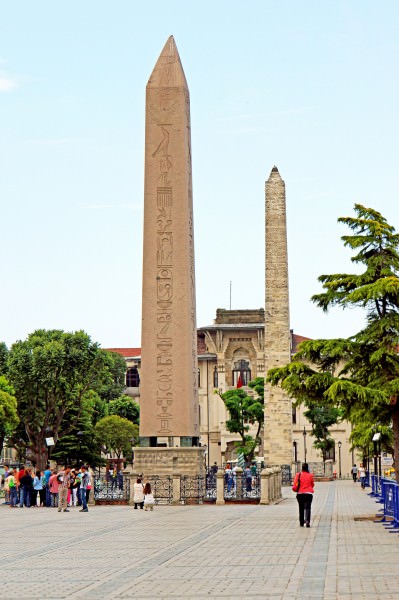
Obelisk of Thutmose III, Istanbul
The quarrying, transport, and raising of an obelisk is well documented through inscriptions, drawings, and official letters on the subject but no specific mention is made of how exactly the obelisk was raised to position on its base. Bunson's description of the funnel-shaped hole draws on ancient Egyptian sources which would seem to indicate that the base of the obelisk was beneath the ramp and covered with sand. The bottom of the obelisk would be positioned over this hole and sand removed slowly to raise the monument while, presumbably, workmen with ropes carefully guided the obelisk as it rose.
The ancient Egyptian inscriptions on this part of the process are unclear, however, and the problem with assuming the funnel-shaped hole in the ramp clarifies anything is that this hole would have to have been of considerable depth to aid in raising a 100 foot tall monument, there would have to have been some kind of groove to prevent slippage on the base, and workers would have needed to find some way to pull the obelisk upright once it had attained a certain height and angle; modern attempts to replicate this process have failed. In 1995 CE a NOVA team with archaeologist Mark Lehner attempted to raise an obelisk based on the Egyptian sources and failed. When they used more modern techniques they failed as well. The funnel-shaped hole of sand would only have had to be deep enough to bring the edge of the bottom of the obelisk down to the edge of a groove in the base but this did not work. Further, the angle of the obelisk as it was rising stopped at 40 degrees and the modern-day workers with their ropes could find no way to raise it further.
In 2001 CE, abandoning the ancient sources, aeronautics professor Mory Gharib and a team raised a 6,900 pound obelisk using kites, a pulley system, and a support frame. Harnessing wind power and calculating leverage needed for the pulley system carefully, the obelisk was raised in 25 seconds. Gharib claims that this was most likely how the ancient obelisks were raised as well as how the pyramids and temples of Egypt were built. This claim, however, is entirely speculative as there are no records indicating a use of kites in construction in ancient Egypt.
Bunson's description, although specifically citing Thebes, would have applied to any of the sites where obelisks were found.Although they were primarily raised at Karnak they were also positioned outside of many temples from Heliopolis (near modern Cairo) in Lower Egypt to Elephantine in Upper Egypt near Aswan.

Obelisk of Senusret I, Heliopolis
OBELISKS & TEMPLES
Obelisks were frequently positioned in the courtyards of temples to honor the god within as well as the sun god who would sail overhead. The only obelisk still standing in its original position is that of Senusret I (c. 1971-1926 BCE) at the site of a former temple to the sun god at Heliopolis. Other obelisks were removed by foreign nations or given as gifts to countries by the Egyptian government in the modern era. Inscriptions and documentation, however, make clear that obelisks were a regular feature of temples throughout ancient Egypt. Wilkinson states:
Symbolic orientation and placement can perhaps be most easily seen in the Egyptian temple, where it was employed constantly at both the macro and micro levels. Many temples were located on sacred sites or built close enough to the Nile to be partially submerged during the river's annual flooding, thus symbolic of the watery creation of the world. Certain late temples also had shrines built on their roofs and crypts below ground level, probably symbols of heaven and the underworld. Most temples were aligned, at least theoretically, with the daily passage of the sun. This alignment is seen in the positioning of the horizon-like pylons, towering obelisks, and solar disks painted along the architraves of the temple's east-west axis (66).
These obelisks would have been carefully measured and cut to conform to the size of a particular temple and the position they would take up there. The point of the pyramidion top of the obelisk was supposed to catch the first and last sun's rays and so the monument had to be high enough and positioned in such a way to accomplish that. The location of the obelisk and its height was the responsibility of the king who would commission both the temple and the complex surrounding it. Wilkinson writes:
From the very foundation of a temple, the king played the dominant role in its construction and functioning.Individual monarchs were responsible for building the successive pylons and courts added to Egypt's greatest temples and even complete structures in other cases. Representations show the king involved in a foundation ritual known as "stretching the cord" which probably took place before work began on the construction of a temple or of any addition. These depictions usually show the king performing the rite with the help of Seshat, the goddess of writing and measurement, a mythical aspect which reinforced the king's central and unique role in the temple construction (174).
Ramesses II (the Great, 1279-1213 BCE) commissioned the greatest number of obelisks for temples and encouraged the continued practice of presenting offerings to them. He positioned his obelisks at the Temple of Amun at Thebes in Upper Egypt down to Heliopolis in Lower Egypt and no doubt had others in his city of Per-Ramesses at the site of the former city of Avaris.Large portions of Per- Ramesses ("the city of Ramesses") were dismantled for the construction of Tanis under the reign of Smendes (c. 1077-1051 BCE) after the Nile changed course and left the former city without a water supply.
Throughout the Third Intermediate Period (c. 1069-525 BCE) Tanis was an important city designed to mirror the much older Thebes and while it is possible obelisks were created for the city at this time it is more probable they were moved from the city of Ramesses. As in every aspect of the construction and positioning of obelisks, the amount of effort to accomplish this would have been considerable but it seems, to the Egyptians, the monuments which pierced the sky and honored the gods were worth the trouble. The rest of the world would seem to agree as Egyptian obelisks, or imitations of the form, can be seen prominently displayed in many modern cities in the present day.
Gregory the Great & His Pastoral Care › Antique Origins
Ancient Civilizations
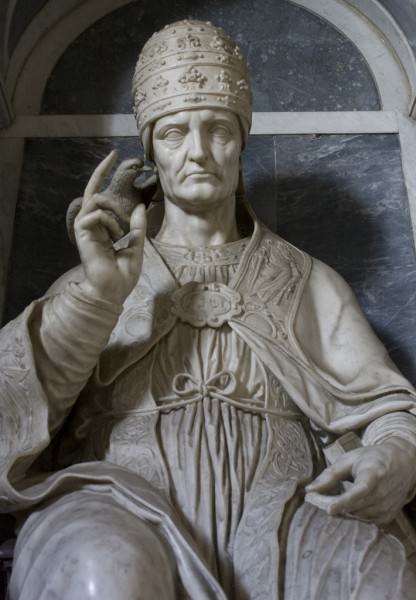
Pope Gregory I
PASTORAL CARE
One of Pope Gregory's most famous literary works is the treatise, Pastoral Care (also known in Latin as Liber Regulae Pastoralis ), a four-book exposition that offers quintessential guidelines for priests and bishops on how to wisely and biblically lead their churches and how to morally manage their lives. In this writing, Gregory presents his papal opinion on the qualifications, attitudes, choices, and activities of being a good pastor, or, as he terms it, "physicians of the heart." (Book I, Ch. 2.)
For Gregory, the office of pastor existed for the benefit of his flock, not the reverse, which he saw happening far too often in medieval society. MacCulloch remarks,
Gregory the former monk saw that this active ministry in the world might afford clergy the chance to make greater spiritual progress than in a monastery, precisely because it was so difficult to maintain contemplative serenity and an ability to expound good news amid the messiness of everyday life. (328-329)
IN GREGORY'S MIND, THE PASTOR MUST BE PROTECTIVE AND PRESERVATIVE IN HIS TREATMENT OF HIS CHURCH FLOCK.
Gregory begins Pastoral Care by pointing out, "Wherefore, let fear temper the desire; but afterwards, authority being assumed by one who sought it not, let his life commend it." (Book I, introduction) The medieval church pastor position was extremely influential; by word or by deed, a pastor could cause spiritual and physical harm to a parishioner (or even lead them to their death), intentionally or unintentionally. Thus, a contemplative, beneficial attitude of servant leadership had to be maintained.Much like the care and concern a physician has in dealing with the health and wellness of his or her patient, in Gregory's mind, the pastor must be protective and preservative in his treatment of his church flock.
BALANCE IN LEADERSHIP & TRUST
Furthermore, even though supposedly a holy physician, a careless pastor might "foul the [same] water," (Book I, Ch. 2.) instead of offering a clear spiritual or biblical solution to the problem besetting the hurting church member. Without proper education and training, the ignorant or worldly pastor could become a stumbling block of destruction rather than the good shepherd leading the sinner to the Good News. Gregory encouraged his readers to find the healthy balance between leadership authority and leadership egomania, being neither too lenient nor too harsh with the suffering parishioner. He writes,
For care should be taken that a ruler show himself to his subjects as a mother in loving-kindness, and as a father in discipline. And all the time it should be seen to with anxious circumspection, that neither discipline be rigid nor loving-kindness lax. (Book II, Ch. 6.)
Trust was another important factor for Gregory concerning pastors and their church, especially considering the number of people dependent upon him. Gregory states,
[A pastor should be] pure in thought, exemplary in conduct, discreet in keeping silence, profitable in speech, in sympathy a near neighbor to everyone, in contemplation exalted above all others, a humble companion to those who lead good lives, erect for his zeal for righteousness against the vices of sinners. (Book II, Ch. 1.)
The pastor should be above reproach so that no obstacles block the approach of his parishioners. People should be eager and willing to receive advice and assistance from their faithful pastor. Moreover, he must perform key pastoral duties and not become arrogant with power and self-righteousness. He writes,
The ruler should be, through humility, a companion of good livers, and, through the zeal of righteousness, rigid against the vices of evil-doers; so that in nothing he prefer himself to the good, and yet, when the fault of the bad requires it, he be at once conscious of the power of his priority; to the end that, while among his subordinates who live well he waives his rank and accounts them as his equals, he may not fear to execute the laws of rectitude towards the perverse. (Book II, Ch. 6.)
Time and time again in Pastoral Care, Gregory expands upon the dangers of over-emphasizing clerical authority and ego, pointing to it as both dangerous and a perversion of human reality. Gregory states,
But since often, when preaching is abundantly poured forth in fitting ways, the mind of the speaker is elevated in itself by a hidden delight in self-display, great care is needed that he may gnaw himself with the laceration of fear, lest he who recalls the diseases of others to health by remedies should himself swell through neglect of his own health; lest in helping others he desert himself, lest in lifting up others he fall. (Book IV)
SELF-AWARENESS
Beneath the clerical robes and priestly authority, the pastor was still filled with the same sinful nature as his parishioners. This demanded great self–awareness and internal evaluation so that the pastor's deeds were performed out of genuine love of neighbor rather than the pastor's love of self. Gregory admonishes,
That they should first shake themselves up by lofty deeds, and then make others solicitous for good living; that they should first smite themselves with the wings of their thoughts; that whatsoever in themselves is unprofitably torpid they should discover by anxious investigation, and correct by strict animadversion, and then at length set in order the life of others by speaking; that they should take heed to punish their own faults by bewailings, and then denounce what calls for punishment in others; and that, before they give voice to words of exhortation, they should proclaim in their deeds all that they are about to speak. (Book III, Ch. 40.)
As he understood ministry, a pastoral calling was given to help deliver sinners from their vices, not to dominate or exploit or condemn them, the common worldly abuses of his age. Hiestand and Wilson advocate for this very same concept when they write, "As a pastor, [one] should consider everything in light of the needs of your church." (121) Thus, Gregory's personal papal challenge to all Christian leaders was that they should continuously examine their own lives, personal vices, and failings before criticizing the lives and behaviors of others in their ministerial positions.
Ultimately, it was Gregory's hope that in contemplating and applying the truths of Pastoral Care, pastors would "rejoice not to be over men, but to do them good. For indeed our ancient fathers are said to have been not kings of men, but shepherds of flocks." (Book II, Ch. 6.)
LICENSE:
Article based on information obtained from these sources:with permission from the Website Ancient History Encyclopedia
Content is available under License Creative Commons: Attribution-NonCommercial-ShareAlike 3.0 Unported. CC-BY-NC-SA License